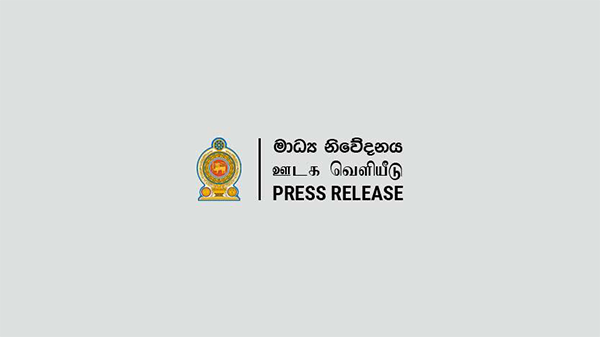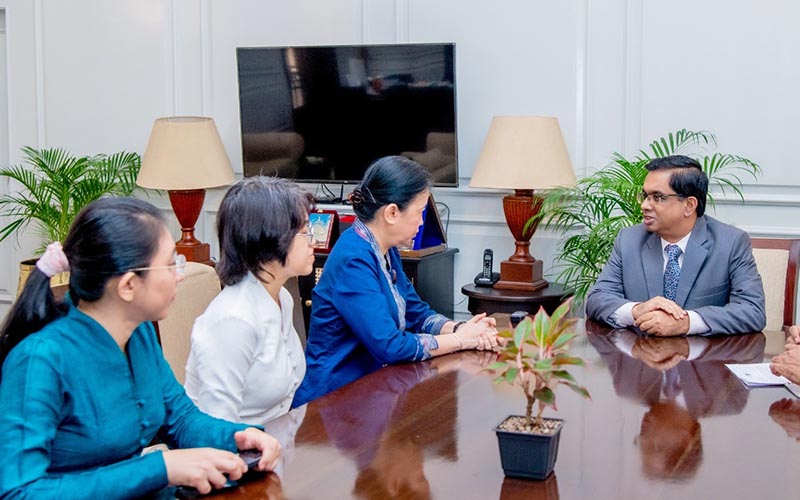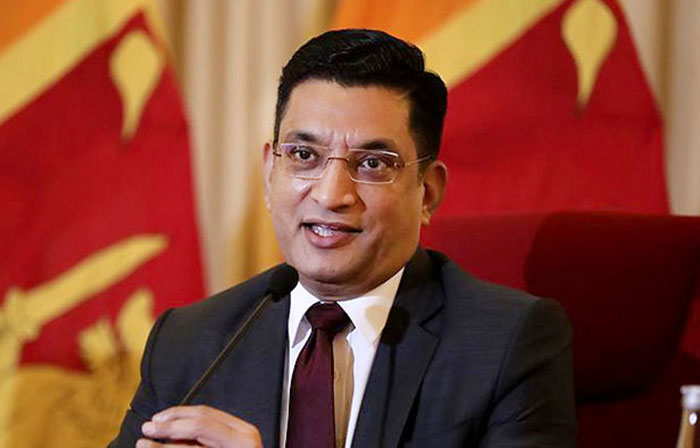News
‘Vulnerable’ South Asia least prepared to deal with urban heat: World Bank

South Asia is one of the regions most at risk due to extreme heat but the majority of its urban areas are ill-equipped to deal with the phenomenon, which is increasing in frequency, severity and complexity due to climate change.
This was stated in a new World Bank report which said that the region, home to a quarter of the world’s population, was accustomed to extreme heat, but rapid urbanisation and climate change were pushing the region’s limits of adaptation with lethal consequences.
The impacts of heat in South Asia are already emerging with over 3,600 heat-related deaths in India and Pakistan during the 2015 heat waves. More recently in 2022, at least one billion people in India and Pakistan experienced further record-breaking heat waves with temperatures reaching 51 degrees Celsius in some parts of Pakistan.
The report, ‘Urban Heat in South Asia: Integrating People and Places in Adapting to Rising Temperature’ said high-density living, along with low permeation of green and blue spaces, has created heat management challenges for a large number of communities in South Asia.
These environmental factors were important considering that heat adaptive measures, such as mechanical cooling through air conditioning, were rarely afforded in South Asia.In many South Asian communities, air conditioning use is impractical due to erratic electricity supply or affordability.
The report stated that across Pakistan, electricity demand often exceeded supply resulting in blackouts lasting three to four hours per day. These factors were not limited to low-income communities and extended across many urban communities in the region.
Urban heat is a rising risk across South Asian cities that is often underestimated and underreported. Unlike many other climate hazards, urban heat is a relatively predictable hazard that can be largely measured and protected against.
The report pointed out that the knowledge of urban temperatures in South Asia has been largely limited to satellite data or studies that have not accounted for spatial variability. This has limited the awareness and understanding of intra-urban heat differences in South Asian cities.
According to the report, South Asian cities face unique challenges, competing demands, and resource constraints, unlike anything in developed economies.Still, lessons could be learnt from outside the region to understand best practices and potential heat management improvements, the report suggested.
While explaining the complications of urban heat, the report said the heat has uneven spatial and social distributions, with wide variations in temperatures and adaptive capacities across buildings and cities around the world.
Urban areas often experience higher temperatures by absorbing more solar radiation than surrounding rural areas, a phenomenon called the urban heat island (UHI) effect, it stated.The existing heat risks in cities were amplified by warming temperatures from climate change as the global surface temperatures have risen 1.1C above pre-industrial levels. These global effects of climate change are further amplified at a local level through the UHI effect.
The report said that between 1950-2017, 60 per cent of the world’s urban population experienced warming twice as large as the global average, and by 2100, 25pc of the world’s largest cities could warm by 7C.
The report emphasised that future heat management efforts should be designed to address both social and spatial vulnerabilities.The cities need to map out overall heat vulnerability, including both heat risk factors, such as building density, materials and access to green/blue spaces, and demographic and socioeconomic determinants, such as income, age, education, gender, health, and social isolation.
There should be inclusive heat planning and policymaking processes to address thermal inequities, particularly in the most vulnerable communities and population groups, the report stated.The report urged policymakers in the region to ensure urban planning and development was adapted to higher temperatures in the face of climate change and the UHI effect.
The cities in the region should integrate people and place in managing the acute and chronic impacts of urban heat by better understanding the heat risks; garnering the necessary human, technical, and financial resources; and embedding urban heat resilience into planning and development processes, the report suggested.
News
34 new projects under “Clean Sri Lanka” programme this year

Under the guidance of President Anura Kumara Disanayake, the “Clean Sri Lanka” programme, implemented as a key government initiative is set to launch 34 new projects this year, and work on many of these projects is scheduled to commence by the end of this April.
In line with this, a one-day workshop was held on Thursday (10) at the “Clean Sri Lanka” Secretariat located in the Lotus Building at the Temple Trees, under the leadership of Secretary to the President Dr. Nandika Sanath Kumanayake. The workshop provided technical guidance on preparing project proposals in accordance with the formats required by the Department of National Planning for submission and approval.
The “Clean Sri Lanka” programme aims to foster social, environmental and ethical transformation across the country, with the active participation of all stakeholders. A sum of Rs. 5 billion has been allocated from this year’s national budget for its implementation.
Once the Department of National Planning grants approval for the proposed projects, detailed action plans will be developed in line with prescribed formats. It was agreed that projects deemed ready for implementation will commence before the end of April.
During the workshop, Secretary to the President outlined the government’s expectations and the intended outcomes of the “Clean Sri Lanka” programme.
Senior officials representing the Ministry of Public Administration, Provincial Councils and Local Government, Ministry of Foreign Affairs, Foreign Employment and Tourism, Ministry of Health and Mass Media, Ministry of Education, Higher Education and Vocational Education, Ministry of Transport, Highways, Ports and Civil Aviation, Ministry of Public Security and Parliamentary Affairs, Ministry of Agriculture, Livestock, Lands and Irrigation, Ministry of Digital Economy, Ministry of Urban Development, Construction and Housing, Ministry of Environment, Ministry of Industries and Entrepreneurship Development, Sri Lanka Police, and the Western Provincial Council were in attendance.
Also present were Engineer S.P.C. Sugeeshwara, Additional Secretary to the President (Clean Sri Lanka Programme) and G.M.R.D. Aponsu, Senior Additional Secretary to the President (Finance and Economic Affairs), along with other senior officials.
[PMD]
News
Financial assistance of USD 01 Million for the Disaster-Affected People of Myanmar

The Government of Sri Lanka has extended financial assistance amounting to USD 01 Million to provide relief to the people of Myanmar affected by the recent earthquake.
The relevant cheque was officially handed over by the Secretary to the President, Dr. Nandika Sanath Kumanayake, to the Ambassador of Myanmar to Sri Lanka, Marlar Than Htaik.on Thursday (10) at the Presidential Secretariat.
Despite the prevailing economic challenges in Sri Lanka, the Ambassador of Myanmar expressed her deep appreciation to President Anura Kumara Disanayake and the Government of Sri Lanka for this gesture of solidarity and support towards the disaster-stricken people of Myanmar.
Furthermore, the Ambassador extended her gratitude for Sri Lanka’s decision to deploy relief teams and medical personnel during this difficult time. She also noted that such acts of compassion further strengthen the longstanding religious and cultural friendship between Sri Lanka and Myanmar.
The Ambassador also briefed the Secretary to the President on the current situation in Myanmar following the earthquake.
Senior Additional Secretary to the President, Roshan Gamage, along with officials from the Embassy of Myanmar, Winh Wint Khaus Tun and Ms. Lei Yi Win, were also present at this occasion.
[PMD]
News
Indo-Lanka MoUs unlikely to be tabled in Parliament any time soon

…of seven SOCs only one constituted so far
Sri Lanka’s controversial MoU on Defence Cooperation with India was unlikely to be taken up any time soon in Parliament in spite of the House Sectoral Oversight Committee (SOC) on Governance, Justice and Civil Protection that has been assigned defence, authoritative sources told The Island.
Of the seven SOCs only one was activated with the recent election of Dr. Najith Indika, MP, as the Chairman of the Sectoral Oversight Committee on Governance, Justice, and Civil Protection of the Tenth Parliament.
The inaugural meeting of the current parliament was held on 21 Nov., 2024.
Sources said that the parliament had met for the last time yesterday (10) before the Sinhala and Tamil New Year holiday. It is scheduled to meet again on May 8.
The UNDP that has financially backed the establishment of the SOC system to help strengthen the role of the parliament recently reached a consensus with the government to reduce the number of SCOCs from 17 to seven. The Island, in writing, asked for the UNDP’s reaction to the operation of SOCs but had not received a response at the time this edition went to press.
The SOCs have the power to examine any Bill, except the Bills defined in Article 152 of the Constitution, Treaty, Reports including the Annual and Performance Reports relating to the institutions coming under its purview or any other matter referred to the Committee by Parliament or any Committee or a Minister relating to the subjects and functions within their jurisdiction.
Sources said that out of the seven SOCs only one had been activated during the past five months though the government and the Opposition agreed to share the leadership of them.
Accordingly, it was agreed that the government would appoint chairpersons to four SOCs –– Economic Development and International Relations, Health, Media and Women’s Empowerment, Science, Technology and Digital Transformation and Governance, Justice and Civil Protection .
It was also agreed that the Opposition would appoint chairpersons to the SOCs on Infrastructure and Strategic Development, Education, Manpower and Human Capital, and Environment, Agriculture and Resource Sustainability to the Opposition.
India and Sri Lanka on April 5 signed six MoUs on HVDC interconnection for import/export of power, cooperation in the field of sharing successful digital solutions implemented at population scale for digital transformation, defence cooperation, multi sectoral grant assistance for Eastern province, health and medicine and pharmacopoeia cooperation. In addition to them, India, Sri Lanka and UAE signed a tripartite MoU cooperation in development of Trincomalee as an energy hub.
The Island asked Ali Sabry, PC, who served as foreign minister during Ranil Wickremesinghe’s tenure as the President (July 2022 to Sept 2024) whether the seven MoUs had been discussed during that period. We also asked him whether those MoUs should have been discussed at SOCs before finalisation.
Sabry said: “Most of the MOU to my knowledge were discussed except the one on Defence Cooperation, which I am unaware of. General procedure is the relevant line ministry prepares the initial draft and gets the input from the Foreign Ministry and goes for stakeholder consultation of all ministries and agencies involved. Then the President’s Office grants its sanction and with the approval of the AG, it goes before the cabinet of ministers. With Cabinet approval, the government could sign the MOU.”
Sabry said that he was of the opinion that once the government signed a particular MoU, it should be placed before the parliament. “MOU’s are generally not legally binding and only signify the desire to work together. If the signed MoUs were to be implemented, then they have to be followed by agreements or laws.”
He emphasised the pivotal importance of transparency in the whole process. The ex-minister said: “I think transparency is crucial in these matters. Concealment leads to speculation and assumption of the worst. The MOUs should be tabled in Parliament for public information. Discussion at the relevant SOCs would have been helpful. There are growing fears fueled by lack of information in the public domain. This is a private comment, not to be attributed to me.
Asked whether MoUs, particularly the ones on defence and energy had to be approved by the Attorney General, the former minister said that the AG has to advise the MoUs compatibility with the Constitution. “But Article 157 of the Constitution does not apply; the 2/3 majority stipulated there envisages only investment treaties.” Foreign Minister Vijitha Herath assured Parliament on April 8 that the AG had cleared all seven MoUs and none of them were inimical to the country.
By Shamindra Ferdinando
-

 Business5 days ago
Business5 days agoColombo Coffee wins coveted management awards
-

 Business7 days ago
Business7 days agoDaraz Sri Lanka ushers in the New Year with 4.4 Avurudu Wasi Pro Max – Sri Lanka’s biggest online Avurudu sale
-

 Features6 days ago
Features6 days agoStarlink in the Global South
-

 Business7 days ago
Business7 days agoNew SL Sovereign Bonds win foreign investor confidence
-

 Features3 days ago
Features3 days agoSri Lanka’s Foreign Policy amid Geopolitical Transformations: 1990-2024 – Part III
-

 Features6 days ago
Features6 days agoModi’s Sri Lanka Sojourn
-

 Midweek Review3 days ago
Midweek Review3 days agoInequality is killing the Middle Class
-

 Features5 days ago
Features5 days agoSri Lanka’s Foreign Policy amid Geopolitical Transformations: 1990-2024 – Part I










